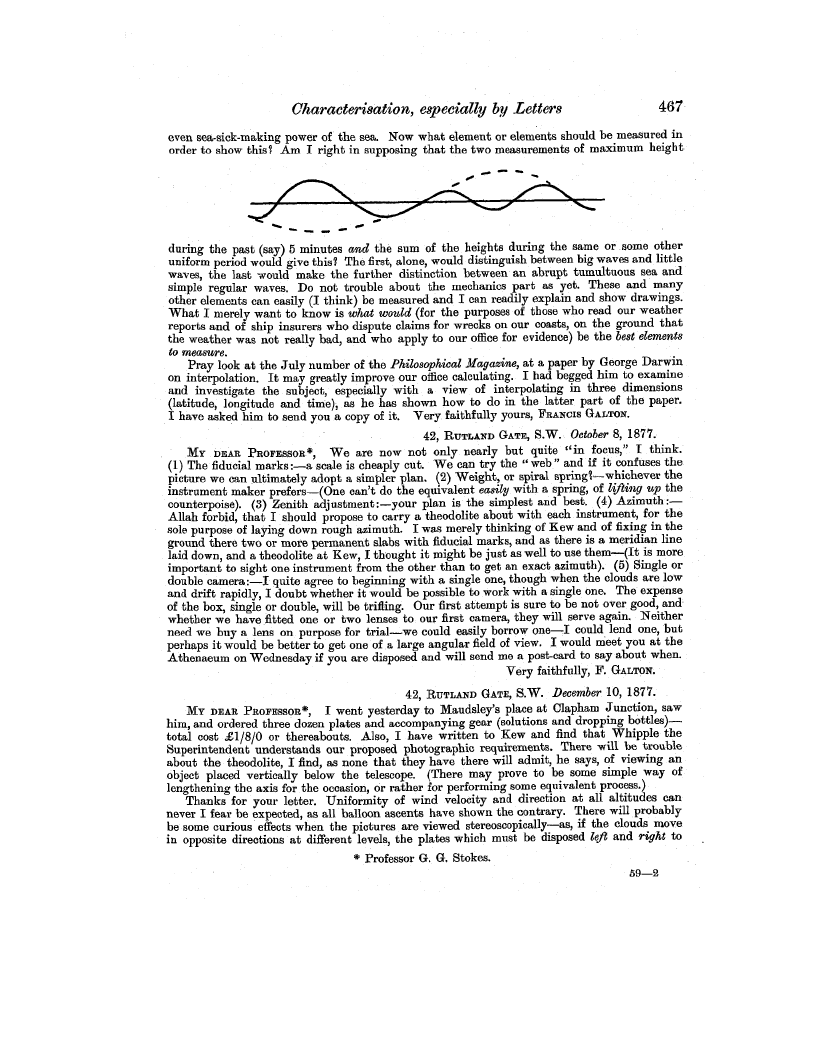| ||||||

OCR Rendition - approximate
Characterisation, especially by Letters 467 even sea-sick-making power of the sea. Now what element or elements should be measured in order to show this? Am I right in supposing that the two measurements of maximum height  during the past (say) 5 minutes and the sum of the heights during the same or some other uniform period would give this? The first, alone, would distinguish between big waves and little waves, the last would make the further distinction between an abrupt tumultuous sea and simple regular waves. Do not trouble about the mechanics part as yet. These and many other elements can easily (I think) be measured and I can readily explain and show drawings. What I merely want to know is what would (for the purposes of those who read our weather reports and of ship insurers who dispute claims for wrecks on our coasts, on the ground that the weather was not really bad, and who apply to our office for evidence) be the best elements to measure. Pray look at the July number of the Philosophical Magazine, at a paper by George Darwin on interpolation. It may greatly improve our office calculating. I had begged him to examine and investigate the subject, especially with a view of interpolating in three dimensions (latitude, longitude and time), as he has shown how to do in the latter part of the paper. I have asked him to send you a copy of it. Very faithfully yours, FRANCIS GALTON. 42, RUTLAND GATE, S.W. October 8, 1877. MY DEAR PROFESSOR*, We are now not only nearly but quite "in focus," I think. (1) The fiducial marks:-a scale is cheaply cut. We can try the "web" and if it confuses the picture we can ultimately adopt a simpler plan. (2) Weight, or spiral spring's-whichever the instrument maker prefers-(One can't do the equivalent easily with a spring, of lifting up the counterpoise). (3) Zenith adjustment:-your plan is the simplest and best. (4) Azimuth:Allah forbid, that I should propose to carry a theodolite about with each instrument, for the sole purpose of laying down rough azimuth. I was merely thinking of Kew and of fixing in the ground there two or more permanent slabs with fiducial marks, and as there is a meridian line laid down, and a theodolite at Kew, I thought it might be just as well to use them-(It is more important to sight one instrument from the other than to get an exact azimuth). (5) Single or double camera:-I quite agree to beginning with a single one, though when the clouds are low and drift rapidly, I doubt whether it would be possible to work with a single one. The expense of the box, single or double, will be trifling. Our first attempt is sure to be not over good, and whether we have fitted one or two lenses to our first camera, they will serve again. Neither need we buy a lens on purpose for trial-we could easily borrow one-I could lend one, but perhaps it would be better to get one of a large angular field of view. I would meet you at the Athenaeum on Wednesday if you are disposed and will send me a post-card to say about when. Very faithfully, F. GALTON. 42, RUTLAND GATE, S.W. December 10, 1877. MY DEAR PROFESSOR*, I went yesterday to Maudsley's place at Clapham Junction, saw him, and ordered three dozen plates and accompanying gear (solutions and dropping bottles)total cost £1/8/0 or thereabouts. Also, I have written to Kew and find that Whipple the Superintendent understands our proposed photographic requirements. There will be trouble about the theodolite, I find, as none that they have there will admit, he says, of viewing an object placed vertically below the telescope. (There may prove to be some simple way of lengthening the axis for the occasion, or rather for performing some equivalent process.) Thanks for your letter. Uniformity of wind velocity and direction at all altitudes can never I fear be expected, as all balloon ascents have shown the contrary. There will probably be some curious effects when the pictures are viewed stereoscopically-as, if the clouds move in opposite directions at different levels, the plates which must be disposed left and right to * Professor G. G. Stokes. 59-2
|